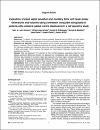Evaluation of nasal septal deviation and maxillary bone and nasal airway dimensions and volumes using cone-beam computed tomography in patients with unilateral palatal canine displacement: a retrospective study

View/
Date
2024-03-11Author
Osman, Safa A. AzimAbu Alhaija, Elham
AlWahadni, Ahed M.
Al Maaitah, Emad F.
Daher, Saba O
Daher, Hasan O
AlTal, Hamza
...show more authors ...show less authors
Metadata
Show full item recordAbstract
Objectives
To detect any association between palatally displaced canine (PDC) and nasal septal deviation (NSD), palatal bone thickness and volume, and nasal airway dimensions and volume.
Materials and Methods
A total of 92 patients were included and subdivided into two groups: group 1, unilateral PDCs (44 patients), and group 2, normally erupted canines (NDCs) (48 subjects). The following variables were measured using cone-beam computed tomography: presence and type of NSD, nasal width, inferior conchae, hard palate and nasal septum thickness, maxillary bone and nasal airway volumes.
Results
NSD was detected in 77% and 50% of PDC and NDC subjects, respectively. Within the PDC subjects, significant differences between the displaced and nondisplaced sides were detected. Palate thickness was increased in the canine region and reduced in the molar region. Compared with the control group, PDC subjects had reduced palate thickness and lower nasal airway volume. Two predictors were significant for predicting the odds of PDC occurrence: NSD and maxillary bone volume.
Conclusions
NSD is more frequent in PDC subjects. PDC subjects have reduced palate thickness and decreased nasal airway volume. In the presence of NSD, the odds of developing PDC increase by 3.35 times, and for each one-unit increase in the maxillary bone volume, the odds of developing PDC decrease by 20%.
Collections
- Dental Medicine Research [394 items ]

